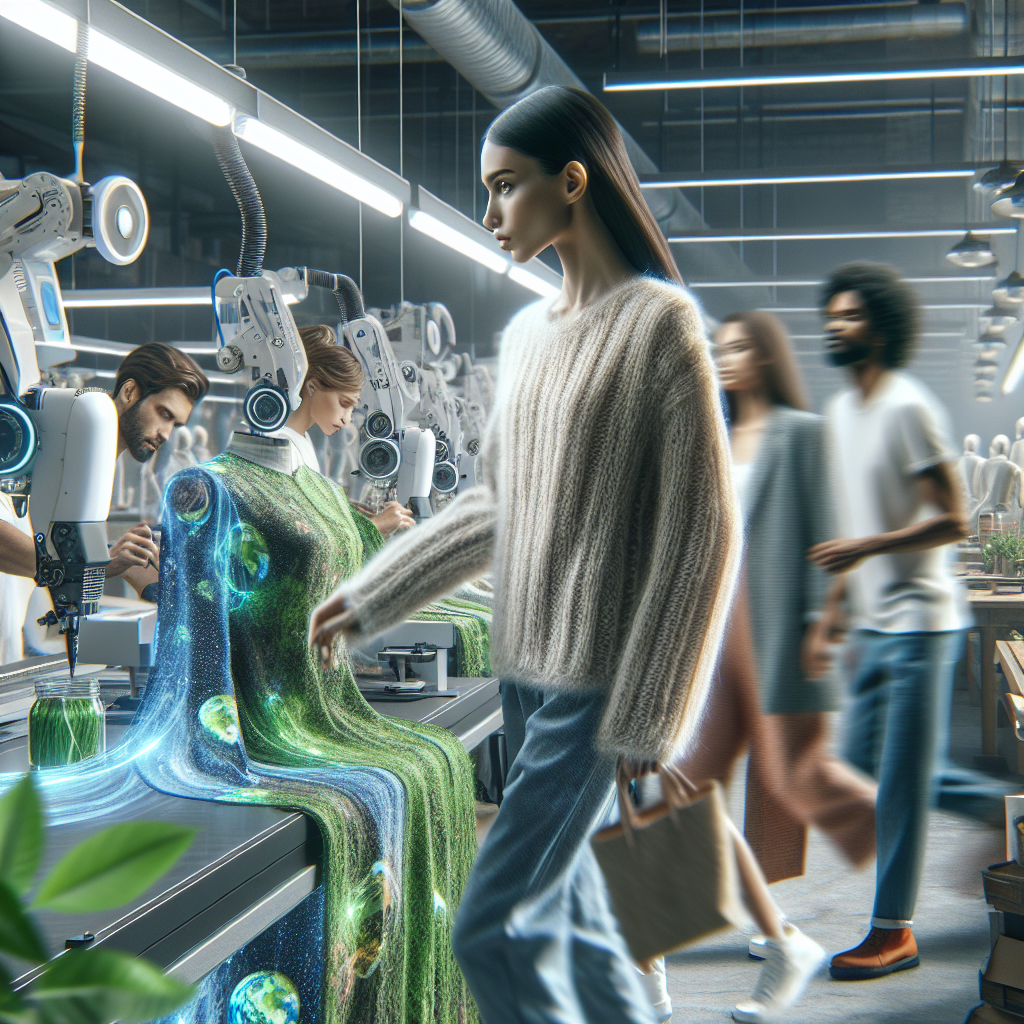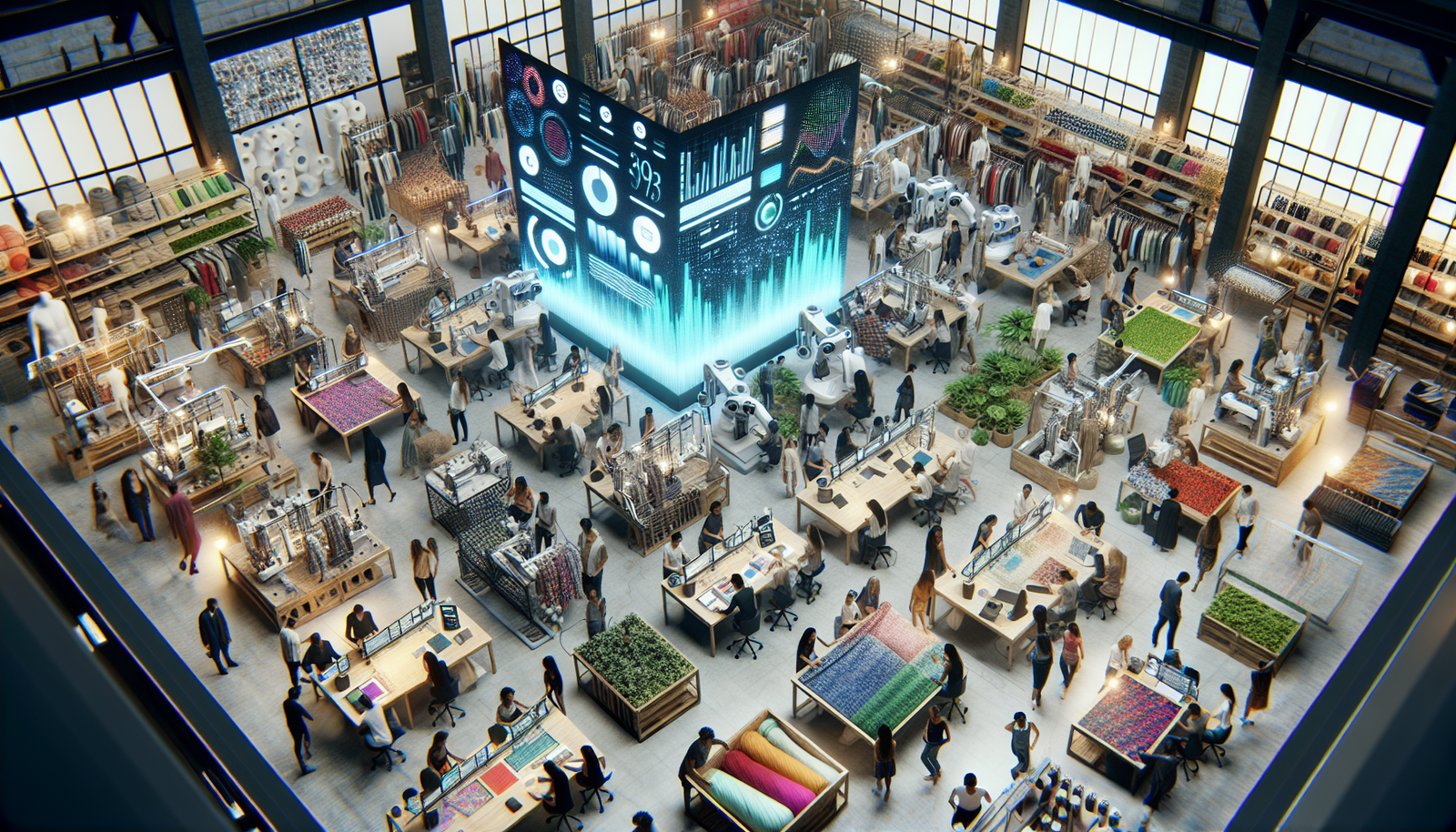The Evolution of Sustainable Fashion
The evolution of sustainable fashion has been a journey marked by significant milestones, each contributing to the industry’s transformation towards eco-friendly practices. Initially, sustainable fashion began as a niche movement, driven by a few pioneering designers and eco-conscious consumers. These early efforts focused on using organic materials, recycling fabrics, and promoting fair trade practices. Over time, the movement gained momentum as awareness about environmental issues and ethical labor practices grew among the general public.
In recent years, the integration of technology and innovation has accelerated the evolution of sustainable fashion. Brands are now leveraging cutting-edge technologies to develop new materials that are both sustainable and functional. For example, innovations in bio-fabrication have led to the creation of materials such as mushroom leather and lab-grown silk, offering eco-friendly alternatives to traditional textiles. Additionally, 3D printing and digital design tools have enabled designers to create intricate patterns and prototypes with minimal waste, further reducing the environmental impact.
Moreover, the rise of the circular economy has played a crucial role in transforming the fashion industry’s approach to sustainability. Companies are increasingly adopting circular business models, where products are designed with their entire lifecycle in mind, promoting reuse, repair, and recycling. Key strategies include take-back programs, where consumers can return used garments for recycling or resale, and the use of biodegradable materials that can decompose without harming the environment. These initiatives not only reduce waste but also encourage a shift in consumer behavior towards more sustainable consumption patterns.
As the fashion industry continues to evolve, the role of artificial intelligence (AI) in driving sustainable practices becomes increasingly apparent. AI technologies are being utilized to optimize supply chains, enabling companies to better predict demand and reduce overproduction. Machine learning algorithms are also assisting designers in creating sustainable collections by analyzing trends and consumer preferences, ensuring that new designs align with both environmental and market needs. This integration of AI into sustainable fashion signifies a new era of innovation, where technology and eco-consciousness work hand in hand to create a more sustainable and responsible fashion industry.
AI’s Role in Reducing Textile Waste
Artificial Intelligence (AI) is making significant strides in addressing the persistent issue of textile waste in the fashion industry. By leveraging advanced algorithms and machine learning, AI is optimizing every stage of the fashion production process to minimize waste. Traditional manufacturing processes often result in substantial fabric waste, but AI-driven technologies are transforming these methods. For instance, AI can analyze and predict fabric usage patterns, allowing manufacturers to cut only the necessary amount of material, thereby reducing excess waste.
One of the primary ways AI contributes to waste reduction is through smart design tools. These tools utilize AI to create virtual samples and prototypes, significantly reducing the need for physical samples, which contribute to waste. Designers can experiment with different styles and materials in a virtual environment, ensuring that the final product is both aesthetically pleasing and resource-efficient. Additionally, AI helps in identifying the most sustainable fabrics and materials, encouraging the use of eco-friendly alternatives that further aid in reducing textile waste.
The implementation of AI in supply chain management is another crucial factor in waste reduction. By employing AI-driven analytics, companies can predict demand more accurately, thus avoiding overproduction—a major contributor to waste. AI tools can track inventory levels in real-time and adjust production schedules accordingly, ensuring that only the necessary amount of clothing is produced. This not only reduces waste but also enhances the overall efficiency of the supply chain.
| AI Application | Impact on Waste Reduction |
|---|---|
| Smart Design Tools | Reduces need for physical samples and promotes use of sustainable materials |
| Supply Chain Management | Prevents overproduction and optimizes inventory levels |
| Fabric Usage Prediction | Minimizes excess material waste during production |
In conclusion, AI is proving to be a powerful ally in the fight against textile waste. By integrating AI technologies into design, production, and supply chain processes, the fashion industry can significantly reduce its environmental impact and move towards a more sustainable future. As AI continues to evolve, its role in minimizing waste is likely to expand, offering even more innovative solutions for sustainable fashion practices.
Ethical Supply Chains Powered by AI
In the realm of sustainable fashion, AI is playing a pivotal role in transforming supply chains to become more ethical and efficient. By leveraging AI technologies, fashion companies can enhance transparency and traceability, ensuring that each step of the supply chain adheres to ethical standards. AI-powered analytics enable brands to monitor and verify the origins of raw materials, ensuring they are sourced responsibly and sustainably. This not only helps in minimizing environmental impact but also in upholding the rights and welfare of workers involved in production.
One of the significant contributions of AI in ethical supply chains is its ability to optimize logistics and reduce waste. Through predictive analytics, AI can forecast demand with greater accuracy, allowing companies to produce only what is necessary, thus minimizing overproduction and waste. Additionally, AI algorithms can identify inefficiencies in the supply chain, suggesting improvements that can reduce the carbon footprint and enhance overall sustainability. This optimization also often results in cost savings, creating a win-win scenario for both businesses and the environment.
Moreover, AI facilitates better decision-making by providing real-time data insights. This capability allows fashion brands to react swiftly to changes in the supply chain, such as disruptions caused by geopolitical events or natural disasters. With AI, companies can identify alternative routes or suppliers promptly, ensuring a continuous and ethical supply chain flow. The integration of AI in these processes not only enhances sustainability but also builds consumer trust, as brands can offer greater transparency about their operations.
| AI Application | Benefit |
|---|---|
| Predictive Analytics | Reduces waste by accurately forecasting demand |
| Real-time Data Insights | Improves decision-making and supply chain agility |
| Traceability Systems | Ensures ethical sourcing and worker welfare |
Personalized Sustainable Fashion with AI
In the realm of sustainable fashion, personalization is becoming increasingly significant, and AI is at the forefront of this transformation. By leveraging data-driven insights, AI algorithms can analyze consumer preferences and behaviors to offer personalized fashion recommendations. This not only enhances customer satisfaction but also aligns with sustainability goals by promoting mindful consumption. Brands are utilizing AI to create personalized shopping experiences that reduce overproduction and waste, as consumers are more likely to purchase items that truly match their style and needs.
One of the key benefits of personalized sustainable fashion is the reduction of returns, which is a considerable challenge in the fashion industry. AI can predict the right size and fit for each customer by analyzing body measurements and previous purchase data. This minimizes the environmental impact associated with shipping and restocking returned items. Additionally, AI-driven personalization encourages the development of capsule wardrobes, where consumers are guided to invest in versatile, high-quality pieces that offer longevity and reduced environmental impact.
AI also assists designers in creating personalized fashion by analyzing trends and consumer feedback. This data can inform design processes, leading to the creation of unique, customer-centric pieces that resonate with target audiences. Furthermore, AI can optimize the supply chain by predicting demand more accurately, ensuring that the right amount of stock is produced, thereby reducing excess inventory and minimizing waste. The integration of AI in sustainable fashion personalization extends beyond consumer interaction to enhance the entire fashion ecosystem.
The impact of AI on personalized sustainable fashion is illustrated through various innovative applications. For instance, some brands employ AI to create virtual fitting rooms, allowing customers to visualize how items will look on them before making a purchase. This not only improves the shopping experience but also supports sustainability by reducing unnecessary returns. Moreover, AI can facilitate the tracking of a garment’s lifecycle, providing transparency and encouraging responsible production and consumption patterns. As AI continues to evolve, its role in driving sustainability through personalized fashion is set to expand, offering exciting possibilities for both consumers and the industry.
AI in Sustainable Design Innovations
Artificial Intelligence (AI) is transforming the landscape of sustainable fashion, offering innovative solutions that push the boundaries of traditional design processes. By leveraging AI, designers can now create more environmentally friendly garments, reducing waste and conserving resources. One way AI contributes to sustainable design is through the use of advanced algorithms that analyze vast amounts of data to predict trends and consumer preferences. This allows designers to tailor their creations to meet demand more accurately, minimizing overproduction and excess inventory.
Another significant innovation is the use of AI-driven design tools that assist in material selection and pattern creation. These tools can evaluate the sustainability of different fabrics and suggest alternatives that have a lower environmental impact. Moreover, AI can optimize the use of materials by determining the most efficient cutting patterns, thus reducing fabric waste. As a result, fashion brands are able to produce clothing that not only meets high aesthetic standards but also adheres to sustainable practices.
AI is also enhancing the customization of fashion, allowing for personalized designs that cater to individual tastes while promoting sustainability. Through machine learning algorithms, AI systems can analyze customer data to offer design suggestions that align with personal preferences and sustainability goals. This level of customization reduces the likelihood of returns and unsold inventory, further contributing to a reduction in waste.
The table below highlights some of the key benefits of AI in sustainable fashion design:
| AI Innovation | Environmental Impact |
|---|---|
| Trend Prediction | Reduces overproduction and waste |
| Material Optimization | Minimizes fabric waste |
| Personalized Design | Decreases returns and excess inventory |
AI and the Circular Fashion Economy
The integration of Artificial Intelligence (AI) into the circular fashion economy is transforming the way the industry approaches sustainability. By leveraging AI, fashion companies are increasingly able to minimize waste and make more informed decisions about resource use. AI technologies help in identifying patterns of consumption and predicting future trends, which allows for more efficient inventory management and reduces the overproduction of garments.
One significant aspect of AI’s role in the circular fashion economy is its ability to enhance recycling processes. AI-powered systems can sort textiles more accurately and efficiently than human workers, separating different types of fibers and materials to ensure they are recycled correctly. This process not only improves the quality of recycled materials but also increases the amount of textile waste that is successfully repurposed. Additionally, AI algorithms are being developed to design clothing with recyclability in mind, ensuring that garments can be easily disassembled and reused at the end of their lifecycle.
AI also plays a crucial part in optimizing supply chains, which is a cornerstone of the circular economy. By utilizing AI, companies can track products throughout their lifecycle, from production to end-user, and back into the recycling loop. This comprehensive tracking system enables brands to identify inefficiencies and make adjustments that reduce environmental impact. AI-driven supply chains are more adaptable and responsive, allowing for real-time adjustments that can prevent waste before it occurs.
The impact of AI on the circular fashion economy extends to consumer engagement as well. AI-driven platforms can provide consumers with information about the sustainability of their purchases, encouraging more environmentally friendly choices. These platforms use AI to analyze data and offer personalized recommendations, fostering a more conscious consumption pattern. As AI continues to evolve, its integration into the circular fashion economy promises to drive significant advancements toward a more sustainable and responsible fashion industry.
Challenges in AI-Driven Sustainable Fashion
As the fashion industry embraces artificial intelligence to drive sustainability, it faces several significant challenges. One of the primary issues is the integration of AI technologies into existing systems. Many fashion companies operate on legacy systems that are not easily compatible with modern AI tools. This necessitates substantial investment in upgrading infrastructure, which can be a daunting prospect for many businesses, especially smaller ones. Furthermore, the lack of standardized data formats across the industry complicates the data sharing and processing essential for AI-driven insights.
Another critical challenge is the ethical implications of AI in sustainable fashion. The use of AI algorithms can inadvertently perpetuate existing biases present in the data they are trained on. This can lead to unfair practices in areas such as labor rights and environmental impact assessments. Additionally, there is a growing concern about data privacy, as AI systems often require vast amounts of consumer data to function effectively. Ensuring that this data is collected and used ethically is paramount to maintaining consumer trust.
- Cost of Implementation: High initial investment for AI technology and training.
- Data Privacy: Ensuring consumer data is protected and used ethically.
- Bias in AI: Addressing and mitigating biases in AI algorithms.
- Infrastructure Compatibility: Upgrading legacy systems to support AI.
Moreover, the fashion industry must tackle the challenge of consumer acceptance. AI-driven sustainable fashion often involves new materials and production methods that consumers may be unfamiliar with or skeptical about. Educating consumers on the benefits and reliability of AI-enhanced sustainable fashion products is crucial. Additionally, the rapid pace of technological advancement means that fashion companies must continuously adapt and innovate, which can be resource-intensive and risky.
| Challenge | Impact | Solution |
|---|---|---|
| Infrastructure Compatibility | Slows down AI adoption | Invest in scalable technology |
| Data Privacy | Loss of consumer trust | Implement robust data protection policies |
| Bias in AI | Unfair labor and environmental practices | Regularly audit AI systems |
| Consumer Acceptance | Resistance to new products | Enhance consumer education efforts |
The Future Outlook for AI in Sustainable Fashion
The integration of Artificial Intelligence in sustainable fashion is poised to redefine the industry, offering a future where fashion is not only trend-responsive but also environmentally and socially responsible. AI technologies are set to enhance efficiency and reduce waste through predictive analytics and advanced algorithms. By analyzing consumer data and trends, AI can anticipate demand more accurately, minimizing overproduction—a major issue in today’s fashion industry. This can lead to a reduction in surplus inventory, which often ends up in landfills, thus promoting a more sustainable production cycle.
Moreover, AI-driven solutions are expected to revolutionize supply chain management. By employing machine learning algorithms, fashion brands can optimize logistics, ensuring that resources are used efficiently and sustainably. This not only reduces costs but also decreases the carbon footprint associated with transportation and distribution. The use of AI in logistics can facilitate a shift towards a circular economy, where materials are reused and recycled, furthering the sustainable agenda.
In design processes, AI offers tools that can inspire creativity while maintaining sustainability. AI can generate thousands of design permutations, allowing designers to explore a wide array of options without the physical waste associated with traditional prototyping. This digital-first approach allows for more sustainable material choices and innovative, eco-friendly design practices. The following table illustrates potential impacts of AI on various aspects of the fashion industry:
| Aspect | AI Impact | Environmental Benefit |
|---|---|---|
| Demand Forecasting | Accurate predictions of fashion trends and consumer preferences | Reduced overproduction and waste |
| Supply Chain Management | Optimized logistics and resource allocation | Lower carbon emissions |
| Design Processes | AI-generated design permutations | Minimized material waste |
As the fashion industry continues to embrace AI, the potential for a significant positive environmental impact grows. The future of fashion lies in leveraging AI to create a sustainable, efficient, and innovative industry that meets the needs of both consumers and the planet. With continued advancements, AI could become an integral part of achieving global sustainability goals, transforming the fashion landscape into a beacon of responsible consumption and production.


